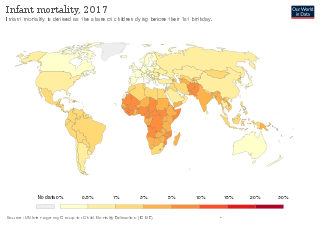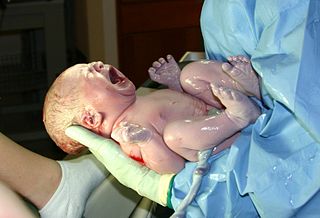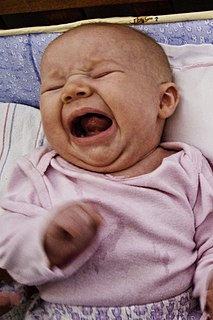
Sudden infant death syndrome (SIDS) is the sudden unexplained death of a child of less than one year of age. Diagnosis requires that the death remain unexplained even after a thorough autopsy and detailed death scene investigation. SIDS usually occurs during sleep. Typically death occurs between the hours of midnight and 9:00 a.m. There is usually no noise or evidence of struggle. SIDS remains the leading cause of infant mortality in Western countries, contributing to half of all post-neonatal deaths.

Infant mortality is the death of young children under the age of 1. This death toll is measured by the infant mortality rate (IMR), which is the probability of deaths of children under one year of age per 1000 live births. The under-five mortality rate, which is referred to as the child mortality rate, is also an important statistic, considering the infant mortality rate focuses only on children under one year of age.

An infant is a formal or specialised synonym for the common term baby, meaning the very young offspring of human beings. The term may also be used to refer to juveniles of other organisms. A newborn is, in colloquial use, an infant who is only hours, days, or up to one month old. In medical contexts, newborn or neonate refers to an infant in the first 28 days after birth; the term applies to premature, full term, and postmature infants.

Brachycephaly is the shape of a skull shorter than typical for its species. It is perceived as a desirable trait in some domesticated dog and cat breeds, notably the pug and Persian, and can be normal or abnormal in other animal species. In humans, the cephalic disorder is known as flat head syndrome, and results from premature fusion of the coronal sutures, or from external deformation. The coronal suture is the fibrous joint that unites the frontal bone with the two parietal bones of the skull. The parietal bones form the top and sides of the skull. This feature can be seen in Down syndrome.

Shaken baby syndrome (SBS), also known as abusive head trauma (AHT), is claimed by some to be the leading cause of fatal head injuries in children younger than 2 years. Diagnosing the syndrome has continuously proved both challenging and contentious for medical professionals, in that they often require objective witnesses to the initial trauma, or rely on uncorroborated recounts. This is said to be particularly problematic when the trauma is deemed 'non-accidental'. Some medical professionals propose that SBS is the result of respiratory abnormalities leading to hypoxia and swelling of the brain However, the courtroom has become a forum for conflicting theories that generally accepted medical literature has not been reconciled with. Often there are no visible signs of trauma. Complications include seizures, visual impairment, cerebral palsy, cognitive impairment and death.

Co-sleeping is a practice in which babies and young children sleep close to one or both parents, as opposed to in a separate room. Co-sleeping individuals sleep in sensory proximity to one another, where the individual senses the presence of others. This sensory proximity can either be triggered by touch, smell, taste, or noise. Therefore, the individuals can be a few centimeters away or on the other side of the room and still have an effect on the other. It is standard practice in many parts of the world, and is practiced by a significant minority in countries where cribs are also used.

Teething is the process by which an infant's first teeth appear by emerging through the gums, typically arriving in pairs. The mandibular central incisors are the first primary teeth to erupt, usually between 6 and 10 months of age and usually causes discomfort and pain to the infant. It can take several years for all 20 teeth to complete the tooth eruption. Though the process of teething is sometimes referred to as "cutting teeth", when teeth emerge through the gums they do not cut through the flesh. Instead, hormones are released within the body that cause some cells in the gums to die and separate, allowing the teeth to come through.

A pacifier is a rubber, plastic, or silicone nipple substitute given to an infant to suckle upon between feedings to quiet its distress by satisfying the need to suck when it does not need to eat. Pacifiers normally have three parts, an elongated teat, a mouth shield, and a handle. The mouth shield is large enough to prevent the child from attempting to take the pacifier into its mouth, and so forecloses the danger that the child will swallow then choke on it.
A language delay is a language disorder in which a child fails to develop language abilities at the usual age-appropriate period in their developmental timetable. It particularly affects deaf children who are denied sign language. It is most commonly seen in children ages two to seven years-old and can continue into adulthood. The reported prevalence of language delay ranges from 2.3 to 19 percent.

An infant bed is a small bed especially for infants and very young children. Infant beds are a historically recent development intended to contain a child capable of standing. The cage-like design of infant beds restricts the child to the bed. Between one and two years of age, children are able to climb out and are moved to a toddler bed to prevent an injurious fall while escaping the bed.

Swaddling is an age-old practice of wrapping infants in blankets or similar cloths so that movement of the limbs is tightly restricted. Swaddling bands were often used to further restrict the infant. Swaddling fell out of favor in the 17th century.

Child abuse or child maltreatment is physical, sexual, and/or psychological maltreatment or neglect of a child or children, especially by a parent or a caregiver. Child abuse may include any act or failure to act by a parent or a caregiver that results in actual or potential harm to a child and can occur in a child's home, or in the organizations, schools, or communities the child interacts with.

Factitious disorder imposed on another (FDIA), also called Munchausen syndrome by proxy (MSbP), is a condition in which a caregiver creates the appearance of health problems in another person, typically their child. This may include injuring the child or altering test samples. The caregiver then presents the person as being sick or injured. Permanent injury or death of the victim may occur as a result of the disorder. The behaviour occurs without a specific benefit to the caregiver.

Stranger anxiety is a form of distress that children experience when exposed to strangers. Stranger anxiety and stranger fear are two interchangeable terms. Stranger anxiety is a typical part of the developmental sequence that most children experience. It can occur even if the child is with a caregiver or another person they trust. It peaks from six to 12 months but may recur afterwards until the age of 24 months. As a child gets older, stranger anxiety can be a problem as they begin to socialize. Children may become hesitant to play with unfamiliar children. Foster children are especially at risk, particularly if they experienced neglect early in their life.
Primitive reflexes are reflex actions originating in the central nervous system that are exhibited by normal infants, but not neurologically intact adults, in response to particular stimuli. These reflexes are suppressed by the development of the frontal lobes as a child transitions normally into child development. These primitive reflexes are also called infantile, infant or newborn reflexes.
Tobacco smoking during pregnancy causes many detrimental effects on health and reproduction, in addition to the general health effects of tobacco. A number of studies have shown that tobacco use is a significant factor in miscarriages among pregnant smokers, and that it contributes to a number of other threats to the health of the foetus.

Infant swimming is the phenomenon of human babies and toddlers reflexively moving themselves through water and changing their rate of respiration and heart rate in response to being submerged. The slowing of heart rate and breathing is called the bradycardic response. It is not true that babies are born with the ability to swim, though they have primitive reflexes that make it look like they are. Babies are not old enough to hold their breath intentionally or strong enough to keep their head above water, and cannot swim unassisted.
Brief resolved unexplained event (BRUE), previously apparent life-threatening event (ALTE), is a medical term in pediatrics that describes an event that occurs during infancy. The event is noted by an observer, typically the infant's caregiver. It is characterized by one or more concerning symptoms such as change in skin color, lack of breathing, weakness, or poor responsiveness. By definition, by the time they are assessed in a healthcare environment they must be back to normal without obvious explanation after the clinician takes the appropriate clinical history and physical examination.
Newborn care and safety are the activities and precautions recommended for new parents or caregivers. It is also an educational goal of many hospitals and birthing centers when it's time to bring their infant home.

Infant crying is the crying of infants as a response to an internal or external stimulus. Infants cry as a form of basic instinctive communication. Essentially, newborns are transitioning from life in the womb to the external environment. Up to 27% of parents describe problems with infant crying in the first four months. Up to 38% identify a problem with their infant crying within the first year. Parents can be concerned about the amount of time that their infant cries, how the infant can be consoled, and disrupted sleeping patterns. Colic is used as a synonym for excessive crying of infants, even though colic may not be the cause of excessive crying.
















